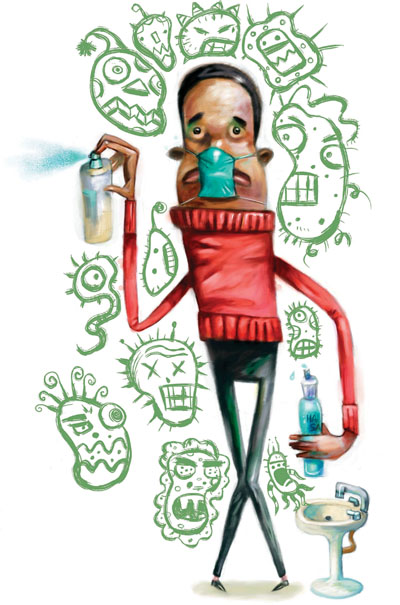
Worried about the spread of H1N1? Join the crowd. The good news
is this: Although swine flu is highly contagious, the World Health
Organization says it generally causes
”
very mild illness
”
in healthy people.
Worried about the spread of H1N1? Join the crowd. The good news is this: Although swine flu is highly contagious, the World Health Organization says it generally causes “very mild illness” in healthy people.
But there are ways to prevent the flu from spreading, mainly by washing your hands.
If doctors sound like your mom, who keeps bugging you to wash your hands before you eat, there’s a reason.
“Whenever you’re contaminated by touching things that other people have touched – desks or tabletops in the lunchroom – you really should wash your hands before eating or drinking or touching your face,” said Dr. Philip Tierno, director of clinical microbiology and immunology at New York University’s Langone Medical Center. Eighty percent of all infections are spread when you touch germs and then touch your mouth, eyes and nose.
And the flu bug is a survivor. The swine-flu virus can survive on a desk or a doorknob for two to eight hours after it lands there, according to the U.S. Centers for Disease Control and Prevention. That’s why hand-washing – and disinfecting lunchroom tables, doorknobs and gym equipment – is so important.
Wash hands
Wash your hands frequently with soap and water. But not so fast! You’re supposed to wash for 20 seconds – so sing “Happy Birthday” to yourself twice to make sure you’ve washed long enough. And don’t just wash your palms. Rub soap on the backs of your hands, between your fingers and underneath your fingernails. Antibacterial soap or plain soap? There’s no need to use antibacterial soap – the water washes away the flu virus.
Hand sanitizer 101
If soap and water are not available, use hand-sanitizing gel. Pick a brand that contains at least 62 percent alcohol. Most important: Wash hands or use hand sanitizer right before you eat lunch – because when you pick up your sandwich, you could spread germs from your hands to your food and then to your mouth.
Coughing and sneezing etiquette
Cough or sneeze into a tissue – and then wash or sanitize your hands. If you don’t have a tissue handy, sneeze or cough into the crook of your arm or your shoulder – so your germs don’t spread through the air. Don’t cough or sneeze into your hands! If you do, wash immediately.
Don’t touch!
Avoid touching your eyes, nose and mouth. That’s the fastest way to spread germs into your body.
Water-fountain phobia?
The danger from the water fountain isn’t from kids putting their mouths on the fountain – because the stream of water washes away germs. The most contaminated part of the fountain is the handle or button you push to turn it on. But to be safe during the swine-flu pandemic, it’s probably best to send kids to school with their own water bottles. What about handrails, doorknobs or keyboards? It’s not practical to ask kids not to touch any surfaces at school. Instead, experts recommend that kids carry their own container of hand sanitizer and use it frequently.
Flu-shot primer
It’s important that children receive a flu shot (or the inhaled flu mist). Those vaccinations are available – either from your doctor’s office or by going to mini-clinics at local pharmacies.
Risky business
Are you at high risk for swine flu? Those with asthma, diabetes, heart disease and kidney disease appear to be more susceptible to the swine flu – as are people who are obese. Because swine flu may cause secondary infections – such as pneumonia – people at high risk may want to get a pneumonia vaccine, too, Tierno said.
Memo to parents
If your child contracts swine flu, limit his contact with others. Don’t let him lounge on the sofa in the living room where he’s likely to be in close contact with other family members. Instead, keep the child in a separate room – preferably one with a bathroom. That way, you don’t have to disinfect the bathroom several times a day. Your child should stay home at least seven days, even if he feels better sooner, to reduce chances of spreading the flu.
Tips for teachers
When children leave the room and change classes, there’s probably little time to wipe down desks with disinfectant. So use a spray disinfectant (such as Lysol or Clorox disinfecting spray) around the room, Tierno said. Choose a brand that has been shown to kill the flu virus.
When cleaning desks and lunchroom tables, skip the soap and water – because you won’t use enough water to wash away the germs. Instead, use a disinfectant or alcohol-based wipes. Also, wipe down or spray doorknobs, keyboards and other frequently touched items in your classrooms, using disinfectants. Gym equipment also should be sanitized frequently.
Most importantly: If you suspect a child is sick, send him or her to the school nurse or the office immediately.









